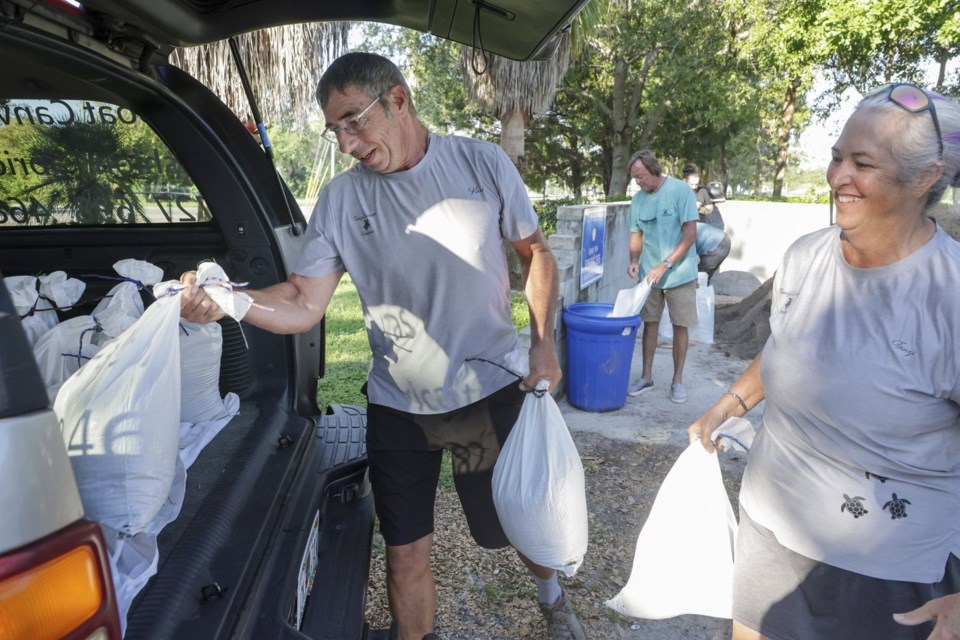ST. PETERSBURG, Fla. (AP) — Another storm system is taking aim at Florida, this time possibly at the Panhandle or Big Bend area, with storm effects expected all over the state due to its vast wind field. The fast-moving Hurricane Helene is intensifying quickly as it crosses from the Caribbean Sea into extremely warm waters in the Gulf of Mexico that are fuel for tropical cyclones.
Here's what to know:
Where is the system?
As of Wednesday morning, Helene was about 500 miles (810 kilometers) southwest of Tampa, Florida, with sustained winds of of 80 mph (130 kph) but forecast to grow stronger, possibly to a Category 3 system or more by Thursday evening, according to the National Hurricane Center. A hurricane warning has been issued for a large swath of the state’s Gulf Coast, from Anclote River, which is in the Tampa Bay area, to Mexico Beach, which took a direct hit when Hurricane Michael slammed into the Florida Panhandle in October 2018. A tropical storm warning was extended Wednesday along the coasts of Georgia and South Carolina.
What is expected?
The Gulf is extremely warm, which is fuel for hurricanes as heat helps the water evaporate faster, producing more rainfall. The overall temperature in the Gulf is about 84 degrees (29 degrees Celsius), somewhat hotter than average, which means the storm will grow in strength.
The lower a storm’s pressure the stronger the storm. The storm’s barometric pressure as of Wednesday morning was 979 millibars but will likely go lower as the storm intensifies. For comparison, Category 5 Hurricane Ian’s minimum estimated pressure was 937 millibars when it hit Fort Myers, Florida, in September 2022.
The National Hurricane Center projects that Helene will make landfall Thursday evening along the Big Bend or Panhandle area of Florida, not the most populated part of the state. The area was hit by Hurricane Debby, a Category 1 storm, in August and Hurricane Idalia last September.
Depending on the track of the storm, portions of Alabama and Georgia could be hit by tropical storm force, or higher winds, and rain.
Likely impacts
A hurricane brings high winds, sometimes enough to tear roofs off houses. But the bigger threat is flooding that can come up from storm drains in addition to water from the Gulf. More people die from flooding than from wind in a hurricane.
Forecasters say up to 15 feet (3 meters) of storm surge is possible along parts of Florida's Gulf Coast, with lesser amounts further down the coast.
Government steps
President Joe Biden has been briefed on Hurricane Helene, and his administration is in touch with officials from states in the storm's path, the White House said Tuesday.
“Federal resources and personnel are prepositioned, including generators, food, and water, along with search and rescue and power restoration teams," White House spokesperson Jeremy Edwards said in a statement. “At the direction of the President, FEMA has also deployed teams to Florida and Alabama to embed with local emergency response personnel to support their efforts, as needed.”
Florida Gov. Ron DeSantis issued a state of emergency Monday afternoon for 61 of Florida’s 67 counties, and another three counties were under a warning or watch.
DeSantis said that Florida hadn't gotten approval for all of its requests for assistance from the federal government but state officials would try again on Wednesday.
Hurricane categories
Hurricanes are measured on the Saffir-Simpson Scale, which measures the strength of a hurricane’s winds on a scale of Category 1 to Category 5, with 5 being the strongest. Forecasters developed the Saffir-Simpson scale — and other tools such as flood maps and storm prediction cones — as a type of shorthand to easily and quickly convey a storm’s severity and reach. But hurricane experts warn that it's not only the storm's strength that matters since a Category 5 storm that’s compact and moving quickly could cause far less damage than a weaker, wetter storm with a huge circumference that stalls over a populated area. The circumference of a storm, how fast it’s moving and the amount of rain it delivers are all factors that matter. The characteristics of the place where it hits also plays a role — its geography, its population and the quality of its infrastructure.
Curt Anderson, The Associated Press



